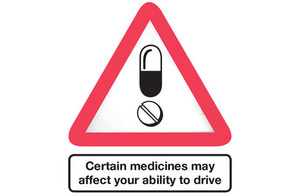Drug drive legislation: am I fit to drive?
New campaign to remind people taking medicines to check with their doctor or pharmacist before getting behind the wheel.

Drug drive sign
New drug drive legislation comes into force from 2 March 2015 in England and Wales. So long as you are following the advice of a healthcare professional and your driving isn’t impaired you can continue to drive as usual and aren’t at risk of arrest.
In the dawn of new drug drive legislation, THINK! is encouraging people who take medicines and aren’t sure if they are safe to drive to check with their pharmacist or doctor. The new law comes into force from the 2nd March and is designed to catch people who risk other people’s lives by getting behind the wheel after taking drugs, and not those taking legitimate medicines that don’t impair their ability to drive.
The new law sets limits at very low levels for 8 drugs commonly associated with illegal use such as cannabis and cocaine. There are also 8 prescription drugs that are included within the new law. These are:
- clonazepam
- diazepam
- flunitrazepam
- lorazepam
- oxazepam
- temazepam
- methadone
- morphine
However, the limits that have been set for these drugs exceed normal prescribed doses, meaning that the vast majority of people can drive as they normally would, so long as:
- they are taking their medicine in accordance with the advice of a healthcare professional and/or as printed in the accompanying leaflet
- their driving is not impaired
Robert Goodwill, Road Safety Minister said:
If you are taking your medicine as directed and your driving is not impaired, then you are not breaking the law and there is no need to worry. We advise anyone who is unsure about the effects of their medication or how the new legislation may affect them, to seek the advice of their doctor or pharmacist
There will also be a medical defence if a driver has been taking medication as directed and is found to be over the limit, but not impaired. THINK! advises drivers who are taking prescribed medication at high doses to carry evidence with them, such as prescriptions slips, when driving in order to minimise any inconvenience should they be asked to take a test by the police.
Professor David Taylor, Royal Pharmaceutical Society spokesperson and member of the Department for Transport advisory panel on drug driving said:
Don’t stop taking your medicines, prescribed or otherwise, if you are worried about this new law. Instead, talk to your doctor or pharmacist for information about how your medicines might affect your ability to drive. They’ll be happy to give you the advice you need to stay safe.
More about the drug drive legislation
For more information speak to your doctor, pharmacist or visit drugs and driving: the law.
Materials to help advise those taking prescription or over the counter medicines can be found at drug driving.
Healthcare guidance is also available to help healthcare professionals prepare and brief their teams.
Drug drive: am I fit to drive?
Table of drugs and limits
| ‘Illegal’ drugs (‘accidental exposure’ – zero tolerance approach) | Threshold limit in blood |
|---|---|
| benzoylecgonine | 50µg/L |
| cocaine | 10µg/L |
| delta-9-tetrahydrocannibinol (cannabis) | 2µg/L |
| ketamine | 20µg/L |
| lysergic acid diethylamide | 1µg/L |
| methylamphetamine | 10µg/L |
| MDMA | 10µg/L |
| 6-monoacetylmorphine (heroin) | 5µg/L |
| ‘Medicinal’ drugs (risk based approach) | Threshold limit in blood |
|---|---|
| amphetamine (regulations were recently laid with the proposed limit and expected to come into force after 2 March 2015) | 250µg/L |
| clonazepam | 50µg/L |
| diazepam | 550µg/L |
| flunitrazepam | 300µg/L |
| lorazepam | 100µg/L |
| methadone | 500µg/L |
| morphine | 80µg/L |
| oxazepam | 300µg/L |
| temazepam | 1,000µg/L |
Drug drive media enquiries
Media enquiries 0300 78777 878
Public enquiries 0300 330 3000